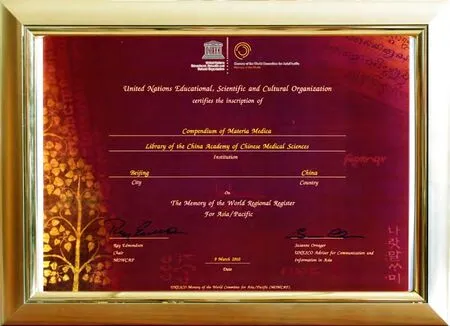Compendium of Materia Medica and Its International Influence
Since the publication of the Compendium of Materia Medica, it has got more than 400 versions both at home and abroad; approximately a new version came out every five to six years. It has been translated into Latin, Italian, French, German,English, Russian, and many other languages, which makes it one of the most translated scientific works from China.
In 1604, the Compendium of Materia Medica was first introduced to Japan. Tokugawa Ieyasu (1543-1616), the founder and first shogun of the Tokugawa shogunate, hailed the book as a masterpiece which could help with his ruling.
The sales volume of herbal medicines in Japan and Korea now accounts for 90% of the global market. It was the Compendium of Materia Medica which set the basis for the success of Japanese Hanfang medicine and Korean medicine today.
In 1650, Polish scholar Michel Boym (1612-1659) translated the Compendium of Materia Medica into Latin and published it in Vienna, setting a precedent for Europeans to study the book.
In the 18th century, French Jesuit historian Jean-Baptiste Du Halde (1674-1743) compiled and published his Geographical,Historical, Chronological,Political, and Physical Description of the Empire of China and Chinese Tartary, which commented that the Compendium of Materia Medica represented the highest level of natural science in the world at the time.

Li Shizhen’s portrait by Jiang Zhaohe蒋兆和绘李时珍像

《本草纲目》的海外影响
《本草纲目》问世后,在国内外出版印刷达400余种,大致5—6年就有一种新版本出现,此外历代都有《本草纲目》的简编本问世,陆续被译成拉丁文、意大利文、法文、德文、英文、俄文等,是中国被译成外文最多的科学著作之一。
1604年,《本草纲目》最早传到日本。江户时代幕府首脑德川家康,将《本草纲目》视作治国安邦的名著。
日、韩本草药物的销售量,目前占国际市场总额的90%,“汉方”“韩医”得以繁衍,才有如今的成就。
1650年,波兰人卜弥格将《本草纲目》译成拉丁文,后在维也纳出版,开创欧洲人研究《本草纲目》的先河。
18世纪,著名汉学家杜赫德编纂刊行《中华帝国通志》,称赞《本草纲目》代表着当时世界自然科学的最高水平。
李时珍创造的植物分类法,比西方植物分类学鼻祖林奈的分类法早170多年。
19世纪,英国博物学家达尔文,吸取引用了《本草纲目》的理论和例证。他将《本草纲目》称为“中国古代百科全书”“东方医药巨典”“人类绿色圣经”。
李时珍像被镶刻在莫斯科大学的世界历史文化名人长廊上。在韩国,还有“李时珍城”等。《本草纲目》首印金陵木刻版陈列在法国卢浮宫、英国不列颠、德国皇家、日本、韩国等博物馆、图书馆(院)内,以福祉全人类健民寿民,昭示普天下永恒敬仰。
英国世界科技史专家、英国皇家科学院院士李约瑟说:“李时珍作为科学家,在与伽利略、维萨里的科学活动隔绝的情况下,能在科学上获得如此辉煌的成就,是任何科学家所不能达到的最高水平。”“毫无疑问,明代最伟大的科学成就,是李时珍那部登峰造极的著作《本草纲目》,至今,这部伟大的著作仍然是研究各门科学史的一个取之不尽的知识源泉。”
1986年11月20日,李约瑟来到李时珍陵园缅怀纪念。
1951年2月,联合国“世界和平理事会”在德国柏林召开。李时珍被推选为世界十大历史文化名人之一。
2011年5月23日,联合国教科文组织将《本草纲目》列入《世界记忆名录》,标志着中国中医药被全世界所认可。2011年6月1日,在中国北京国家图书馆召开《本草纲目》入选《世界记忆名录》新闻发布会,正式向全球公布。
李时珍及其《本草纲目》在海内外人民心目中,拥有“医中之圣”的崇高地位,拥有跨越国界、种族、信仰的感召力。

Compendium of Materia Medica listed in the Asia/Pacific Memory of The World Register 《本草纲目》入选《世界记忆(亚太区)名录》

Compendium of Materia Medica listed in the International Memory of the World Register《本草纲目》入选《世界记忆(全球)名录》
The plant taxonomy system created by Li Shizhen is more than 170 years older than the classification system of Carl von Linné (1707-1778), the founder of Western plant taxonomy.
In the 19 th century,Charles Darwin, the British naturalist, drew on the theories and examples cited in the Compendium of Materia Medica.He referred to it as an “ancient Chinese encyclopedia,” “oriental medicine giant,” and “green Bible of mankind.”
At Moscow University, Li Shizhen’s name was engraved on the promenade of world history and cultural celebrities.There are also other places in the world like Li Shizhen City in Korea which has been set up in memory of this medical sage. Different editions of the Compendium of Materia Medica published in the Ming Dynasty and the Qing Dynasty (1644-1912) are collected by the British Library, Cambridge University Library, Oxford University Library, French National Library,German National Library, the U.S. Library of Congress, National Library of Korea, and libraries in Russia, Italy and Denmark. To this day, this great work is still an inexhaustible knowledge source for the study of all kinds of science history.
Joseph Needham (1900-1995),the British expert on the history of science and technology and a member of the Royal Academy of Sciences, commented,“Undoubtedly the greatest scientific achievement of the Ming was the culminating work of the pen tsao series (the Compendium of Materia Medica)… Li Shih-Chen (Li Shizhen) attained as high a rank qua a scientist as it was possible for anyone to attain in isolation from the Galilean-Vesalian movement.”
On November 20, 1986, Joseph Needham visited Li Shizhen’s cemetery for commemoration.
At the UN “World Peace Council” held in February of 1951,Li Shizhen was elected as one of the world’s ten historical and cultural celebrities.
On May 23, 2011, the Compendium of Materia Medica was included in UNESCO’s Memory of the World Register, which marked the global recognition of traditional Chinese medicine.
Li Shizhen with his Compendium of Materia Medica holds a lofty status of “medical sage” in people’s mind both at home and abroad. Their charisma transcends national borders, race,and beliefs.

Spring in the “Capital of Chinese Mugwort ” 艾都春色

